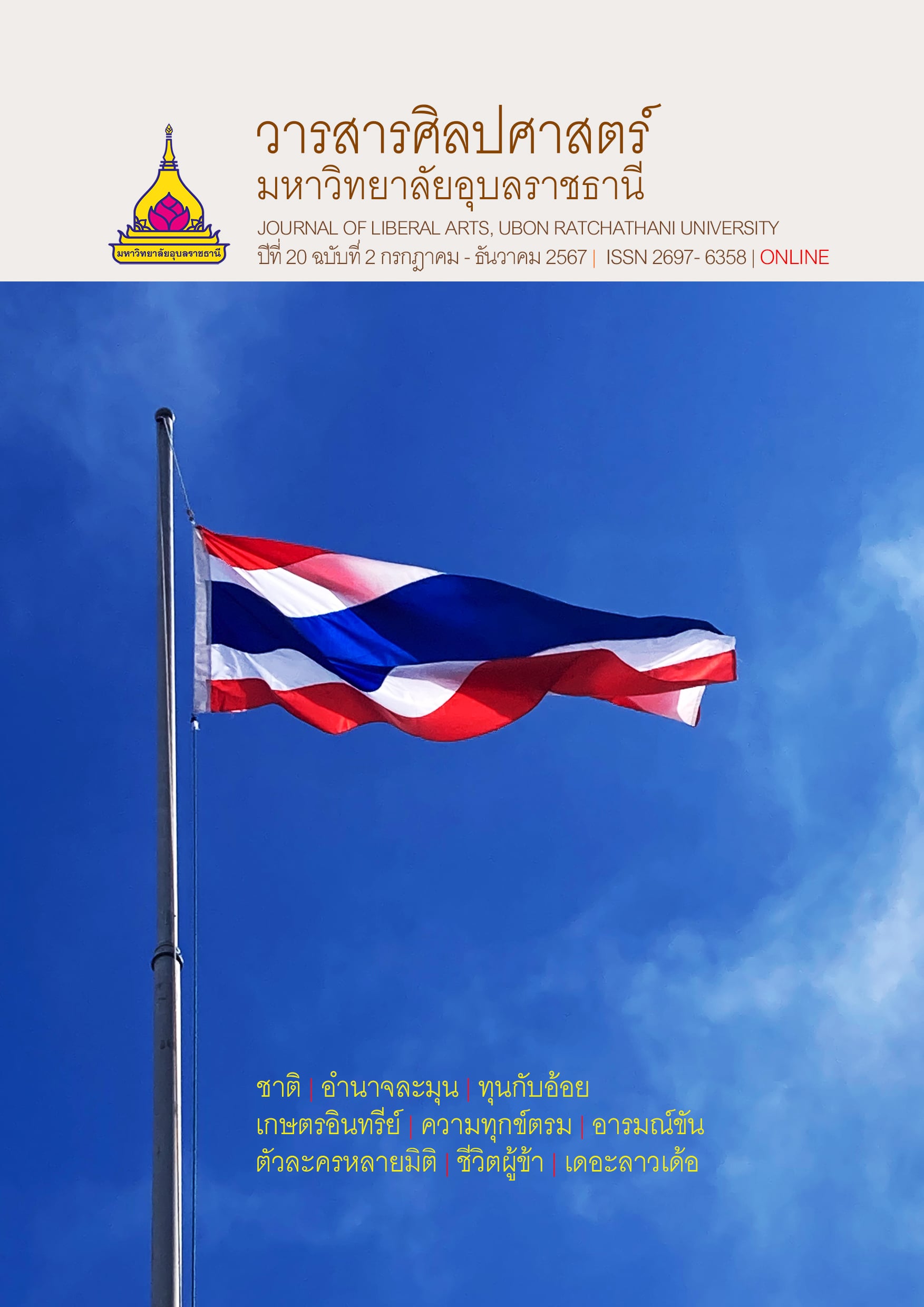กลวิธีการสร้างอารมณ์ขันและการใช้ภาษา ในช่องยูทูบ “Ananped”
Main Article Content
บทคัดย่อ
บทความนี้มีวัตถุประสงค์เพื่อศึกษากลวิธีการสร้างอารมณ์ขันและการใช้ภาษาในช่องยูทูบ “Ananped” โดยคัดเลือกตอนที่มียอดผู้เข้าชมสูงสุด จำนวน 50 คลิปวิดีโอ ตั้งแต่วันที่ 1 มกราคม 2565 ถึงวันที่ 31 ธันวาคม 2565 สํารวจข้อมูลเมื่อวันที่ 14 มกราคม พ.ศ. 2566 ผลการศึกษากลวิธีการสร้างอารมณ์ขันในช่องยูทูบ “Ananped” พบกลวิธีการสร้างอารมณ์ขันทั้งหมด 9 กลวิธี โดยเรียงลำดับจากมากไปน้อย ได้ดังนี้ พบกลวิธีการยั่วล้อมากที่สุด รองลงมาพบการหักมุมและพลิกความคาดหมาย การเสแสร้งและเจ้าเล่ห์เพทุบาย การเล่นเลอะเทอะ แตกหักทำลาย และทำให้เจ็บตัว การใช้ตรรกวิทยาแบบผิด ๆ การแต่งกายแปลกประหลาด การเข้าใจผิดและเข้าใจคนละทาง การล้อเล่นเกี่ยวกับเรื่องความตาย และพบการทำให้เป็นเรื่องเพศและเรื่องสัปดนน้อยที่สุด ผลการศึกษาการใช้ภาษาในช่อง ยูทูบ “Ananped” พบการใช้ภาษาทั้งหมด 13 ลักษณะ โดยเรียงลำดับจากมากไปน้อย ได้ดังนี้ พบการใช้คำภาษาต่างประเทศมากที่สุด รองลงมาพบการใช้คำรุนแรง การใช้ภาษาที่แสดงน้ำเสียงต่าง ๆ การใช้ภาษาเฉพาะกลุ่ม การใช้จังหวะในการพูด การเล่นคำ การตัดคำ การตั้งสมญานามให้กับบุคคล การใช้คำภาษาถิ่น การสร้างคำและสำนวนขึ้นใหม่ การใช้ภาษาขัดแย้ง การเลี่ยงคำหยาบ และพบการใช้คำผิดแบบแผนน้อยที่สุด
Downloads
Article Details

อนุญาตภายใต้เงื่อนไข Creative Commons Attribution-NonCommercial-NoDerivatives 4.0 International License.
เอกสารอ้างอิง
Chanbanchee, Y. (2008). The Techniques of Thai Humor in The Prose of Ketsaepasawas Palakawong Na Ayudha. [in Thai]. Master of Education Field of Study: Linguistics Studies, Srinakharinwirot University.
Eiamutama, T. (2008). The Strategies and the Use of Humour Language in the Series Breaks of the Variety Game Show “Ching Roy Ching Laan”. [in Thai]. N.P.: University of the Thai Chamber of Commerce.
Ekyhaweng, A. (2024). YouTube channel “Ananped”. https://www.youtube.com/@Ananped.
Inthonsin, S. (2021). Strategies Creating Humour in Pinda Phosaya’s Written Pieces. [in Thai]. Journal of Modern Learning Development, 6(2), 333-334.
Jaroenkiatboworn, K. (2005). A Discourse Analysis of Jokes In Thai. [in Thai]. PhD in Linguistics, Chulalongkorn University.
Jampa, Ph. et al. (2016). The Contents and the Words Expressing Humor in “Toei Tiew Thai” Program. [in Thai]. Journal of Humanities and Social Sciences, Bansomdejchaopraya Rajabhat University, 10(1), 18-19.
Isaan Roi Paet. (2023a). Saep (Tasty). [in Thai]. https://esan108.com/dict/#gsc.tab=0.Isaan Roi Paet. (2023b). Mue Ni (Today). [in Thai].
Pantthakernamorn, T. (2016). Humor in Nonfiction Writing: A Constructive Critical Analysis. [in Thai]. Chulalongkorn University Press.
Pochananukrian. (2023). Set Yaw (Looking for taking advantage of you). [in Thai].https://pojnanukrian.com/%E0%B9%80%E0%B8%8B%E0%B9%87%E0%B8%94%E0%B8%AB%E0%B8%A2%E0%B9%88%E0%B8%AD.
Royal Academy. (2011). Royal Institute Dictionary. [in Thai]. Bangkok: Nammee Books.
Sanguanphong, S. (2020). The Humor in Toey-Tiew-Thai. [in Thai]. Master of Arts (Thai Language Major), Silpakorn University.
Siriyuwasak, U. (1993). Humor in the Mass Media. [in Thai]. Bangkok: Research and Development Book Project Communication Arts Development.
Southern language. (2023). Roi Raeng (Tasty). [in Thai]. https://shorturl.asia/1M5cn.
Thananet, P. (2009). Study of Language Use in the Comic Book Ramayana, Ramaavatara Edition. [in Thai]. Master of Arts Srinakharinwirot University.
Thongprasit, P. (2012). A Study of Language Usage and Thai Humour Techniques in Situation Comedy. [in Thai]. Master of Arts (Thai Language), Kasetsart University.
Toyaboot, K. et al. (2020). The Strategy of Content Presentation of Youtuber. Case Study: Chompoo Sangchan’s Channel. [in Thai]. The 8th
National Academic Conference on Business Administration. 5 February 2021, Faculty of Business Administration, Maejo University.


